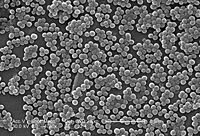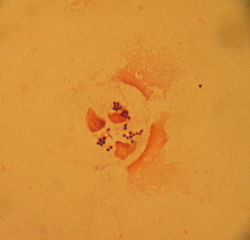- Staphylococcus aureus
-
Scanning electron micrograph of S. aureus, 20,000 times enlargement, false color added 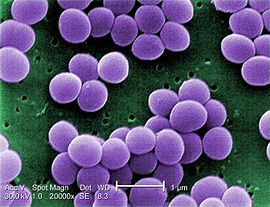
Scientific classification Domain: Bacteria Kingdom: Eubacteria Phylum: Firmicutes Class: Bacilli Order: Bacillales Family: Staphylococcaceae Genus: Staphylococcus Species: aureus Binomial name Staphylococcus aureus
Rosenbach 1884Staphylococcus aureus (
 /ˌstæfɨlɵˈkɒkəs ˈɔriəs/; meaning the "golden grape-cluster berry," and also known as "golden staph" and Oro staphira) is a facultative anaerobic Gram-positive coccal bacterium. It is frequently found as part of the normal skin flora on the skin and nasal passages.[1] It is estimated that 20% of the human population are long-term carriers of S. aureus.[1] S. aureus is the most common species of staphylococci to cause Staph infections. The reasons why S. aureus is a successful pathogen are a combination host and bacterial immuno-evasive strategies. One of these strategies is the production of carotenoid pigment staphyloxanthin which is responsible for the characteristic golden colour of S. aureus colonies. This pigment acts as a virulence factor, primarily being a bacterial antioxidant which helps the microbe evade the hosts immune system in the form of reactive oxygen species which the host uses to kill pathogens.[2][3]
/ˌstæfɨlɵˈkɒkəs ˈɔriəs/; meaning the "golden grape-cluster berry," and also known as "golden staph" and Oro staphira) is a facultative anaerobic Gram-positive coccal bacterium. It is frequently found as part of the normal skin flora on the skin and nasal passages.[1] It is estimated that 20% of the human population are long-term carriers of S. aureus.[1] S. aureus is the most common species of staphylococci to cause Staph infections. The reasons why S. aureus is a successful pathogen are a combination host and bacterial immuno-evasive strategies. One of these strategies is the production of carotenoid pigment staphyloxanthin which is responsible for the characteristic golden colour of S. aureus colonies. This pigment acts as a virulence factor, primarily being a bacterial antioxidant which helps the microbe evade the hosts immune system in the form of reactive oxygen species which the host uses to kill pathogens.[2][3]S. aureus can cause a range of illnesses from minor skin infections, such as pimples, impetigo, boils (furuncles), cellulitis folliculitis, carbuncles, scalded skin syndrome, and abscesses, to life-threatening diseases such as pneumonia, meningitis, osteomyelitis, endocarditis, toxic shock syndrome (TSS), bacteremia, and sepsis. Its incidence is from skin, soft tissue, respiratory, bone, joint, endovascular to wound infections. It is still one of the five most common causes of nosocomial infections, often causing postsurgical wound infections. Each year, some 500,000 patients in American hospitals contract a staphylococcal infection.[4]
Methicillin-resistant S. aureus, abbreviated MRSA and often pronounced "mer-sa" (in North America), is one of a number of greatly-feared strains of S. aureus which have become resistant to most antibiotics. MRSA strains are most often found associated with institutions such as hospitals, but are becoming increasingly prevalent in community-acquired infections. A recent study by the Translational Genomics Research Institute showed that nearly half (47%) of the meat and poultry in U.S. grocery stores were contaminated with S. aureus, with more than half (52%) of those bacteria resistant to antibiotics.[5]
S. aureus was first identified in Aberdeen, Scotland (1880) by the surgeon Sir Alexander Ogston in pus from surgical abscesses.[6] Abbreviated to S. aureus or Staph aureus in medical literature, Staphylococcus as a generic name in binomial nomenclature is capitalized when used alone or with a specific species. However, it is not capitalized or italicized when used in adjectival forms (as in a staphylococcal infection), or as the plural (staphylococci).[7] Staphylococcus should not be confused with the similarly-named and medically relevant genus Streptococcus.
Staphylococcus aureus Classification and external resources ICD-9 041.11 Contents
Microbiology
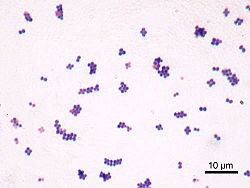 Gram stain of S. aureus cells which typically occur in clusters. The cell wall readily absorbs the crystal violet stain.
Gram stain of S. aureus cells which typically occur in clusters. The cell wall readily absorbs the crystal violet stain.
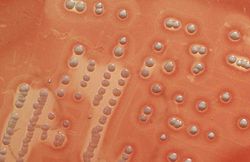 Yellow colonies of S. aureus on a blood agar plate, note regions of clearing around colonies caused by lysis of red cells in the agar (beta hemolysis)
Yellow colonies of S. aureus on a blood agar plate, note regions of clearing around colonies caused by lysis of red cells in the agar (beta hemolysis)
S. aureus is a facultatively anaerobic, Gram-positive coccus, which appears as grape-like clusters when viewed through a microscope, and has large, round, golden-yellow colonies, often with hemolysis, when grown on blood agar plates.[8] The golden appearance is the etymological root of the bacterium's name; aureus means "golden" in Latin.
S. aureus is catalase-positive (meaning it can produce the enzyme catalase), so is able to convert hydrogen peroxide (H2O2) to water and oxygen, which makes the catalase test useful to distinguish staphylococci from enterococci and streptococci. A small percentage of S. aureus can be differentiated from most other staphylococci by the coagulase test: S. aureus is primarily coagulase-positive (meaning it can produce the enzyme coagulase) that causes clot formation, whereas most other Staphylococcus species are coagulase-negative.[8] However, while the majority of S. aureus are coagulase-positive, some may be atypical in that they do not produce coagulase (the most common organism in patients with nosocomial bacteremia is coagulase-negative staphylococcus.[9]) Incorrect identification of an isolate can impact implementation of effective treatment and/or control measures.[10]
Role in disease
Further information: Coagulase-positive staphylococcal infectionStrains are responsible for food poisoning through the production of an enterotoxin, and pathogenicity is also associated with coagulase positivity.
S. aureus may occur as a commensal on skin; it also occurs in the nose frequently (in about a third of the population)[11] and the throat less commonly. The occurrence of S. aureus under these circumstances does not always indicate infection and, therefore, does not always require treatment (indeed, treatment may be ineffective and recolonisation may occur). It can survive on domesticated animals, such as dogs, cats, and horses, and can cause bumblefoot in chickens. It can survive for hours to weeks, or even months, on dry environmental surfaces, depending on strain.[12] It can host phages, such as Panton-Valentine leukocidin, that increase its virulence.
S. aureus can infect other tissues when barriers have been breached (e.g., skin or mucosal lining). This leads to furuncles and carbuncles (a collection of furuncles). In infants, S. aureus infection can cause a severe disease - staphylococcal scalded skin syndrome (SSSS).[13]
S. aureus infections may spread through contact with pus from an infected wound, skin-to-skin contact with an infected person by producing hyaluronidase that destroys tissues, and contact with objects such as towels, sheets, clothing, or athletic equipment used by an infected person. Deeply penetrating S. aureus infections can be severe. Prosthetic joints put a person at particular risk for septic arthritis, and staphylococcal endocarditis (infection of the heart valves) and pneumonia, which may be rapidly spread at slow rates.
Atopic dermatitis
S. aureus is extremely prevalent in atopic dermatitis patients who are less resistant to it than other people. It often causes complications, and this disease is mostly found in fertile, active places, including the armpits, hair, and scalp. The large pimples that appear in those areas may cause the worst of the infection if popped. This can lead to staphylococcal scalded skin syndrome (SSSS). A severe form, Ritter's disease, is seen in neonates.
Toxic shock syndrome and S. aureus food poisoning
Some strains of S. aureus, which produce the exotoxin TSST-1, are the causative agents of toxic shock syndrome. Some strains of S. aureus also produce an enterotoxin that is the causative agent of S. aureus gastroenteritis. The gastroenteritis is self-limiting, with the person recovering in eight to 24 hours. Symptoms include nausea, vomiting, diarrhea, and major abdominal pain. Lack of antibody to TSST-1 plays a part in the pathogenesis of toxic shock syndrome.
Mastitis in cows
S. aureus is one of the causal agents of mastitis in dairy cows. Its large polysaccharide capsule protects the organism from recognition by the cow's immune defenses.[14]
Reproduction
S. aureus reproduces asexually. It starts this process by reproducing its DNA. The membrane stretches out and separates the DNA molecules. The cells form a hollow space that eventually divides into two new cells. The new cell wall does not fully separate from the existing cell wall, which is why the cells are observed in clusters. This cell will eventually reproduce, and cells will attach to it.[15]
Virulence factors
Toxins
Depending on the strain, S. aureus is capable of secreting several exotoxins, which can be categorized into three groups. Many of these toxins are associated with specific diseases.
- Superantigens
- (PTSAgs) have superantigen activities that induce toxic shock syndrome (TSS). This group includes the toxin TSST-1, which causes TSS associated with tampon use. This is characterized by fever, erythematous rash, hypotension, shock, multiple organ failure, and skin desquamation. The staphylococcal enterotoxins, which cause a form of food poisoning characterized by vomiting and diarrhea one to six hours after ingestion of the toxin, are included in this group.
- Exfoliative toxins
- EF toxins are implicated in the disease staphylococcal scalded-skin syndrome (SSSS), which occurs most commonly in infants and young children. It also may occur as epidemics in hospital nurseries. The protease activity of the exfoliative toxins causes peeling of the skin observed with SSSS.
- Other toxins
- Staphylococcal toxins that act on cell membranes include alpha toxin, beta toxin, delta toxin, and several bicomponent toxins. The bicomponent toxin Panton-Valentine leukocidin (PVL) is associated with severe necrotizing pneumonia in children. The genes encoding the components of PVL are encoded on a bacteriophage found in community-associated methicillin-resistant S. aureus (MRSA) strains.
Protein A
Protein A is anchored to staphylococcal peptidoglycan pentaglycine bridges (chains of five glycine residues) by the transpeptidase sortase A.[16] Protein A, an IgG-binding protein, binds to the Fc region of an antibody. In fact, studies involving mutation of genes coding for protein A resulted in a lowered virulence of S. aureus as measured by survival in blood, which has led to speculation that protein A-contributed virulence requires binding of antibody Fc regions.[17] Protein A in various recombinant forms has been used for decades to bind and purify a wide range of antibodies by immunoaffinity chromatography. Transpeptidases, such as the sortases responsible for anchoring factors like Protein A to the staphylococcal peptidoglycan, are being studied in hopes of developing new antibiotics to target MRSA infections.[18]
Role of pigment in virulence
Some strains of S. aureus are capable of producing staphyloxanthin - a carotenoid pigment that acts as a virulence factor. It has an antioxidant action that helps the microbe evade death by reactive oxygen species used by the host immune system. Staphyloxanthin is responsible for its characteristic golden colour.[2] When comparing a normal strain of S. aureus with a strain modified to lack staphyloxanthin, the wildtype pigmented strain was more likely to survive incubation with an oxidizing chemical, such as hydrogen peroxide, than the mutant strain was. Colonies of the two strains were also exposed to human neutrophils. The mutant colonies quickly succumbed, while many of the pigmented colonies survived. Wounds on mice were inoculated with the two strains. The pigmented strains created lingering abscesses. Wounds with the unpigmented strains healed quickly.
These tests suggest the staphyloxanthin may be key to the ability of S. aureus to survive immune system attacks. Drugs designed to inhibit the bacterium's production of the staphyloxanthin may weaken it and renew its susceptibility to antibiotics.[3] In fact, because of similarities in the pathways for biosynthesis of staphyloxanthin and human cholesterol, a drug developed in the context of cholesterol-lowering therapy was shown to block S. aureus pigmentation and disease progression in a mouse infection model.[19]
Classical diagnosis
Depending upon the type of infection present, an appropriate specimen is obtained accordingly and sent to the laboratory for definitive identification by using biochemical or enzyme-based tests. A Gram stain is first performed to guide the way, which should show typical Gram-positive bacteria, cocci, in clusters. Second, the isolate is cultured on mannitol salt agar, which is a selective medium with 7–9% NaCl that allows S. aureus to grow, producing yellow-colored colonies as a result of mannitol fermentation and subsequent drop in the medium's pH. Furthermore, for differentiation on the species level, catalase (positive for all Staphylococcus species), coagulase (fibrin clot formation, positive for S. aureus), DNAse (zone of clearance on nutrient agar), lipase (a yellow color and rancid odor smell), and phosphatase (a pink color) tests are all done. For staphylococcal food poisoning, phage typing can be performed to determine whether the staphylococci recovered from the food were the source of infection.
Rapid diagnosis and typing
Diagnostic microbiology laboratories and reference laboratories are key for identifying outbreaks and new strains of S. aureus. Recent genetic advances have enabled reliable and rapid techniques for the identification and characterization of clinical isolates of S. aureus in real time. These tools support infection control strategies to limit bacterial spread and ensure the appropriate use of antibiotics. Real-time PCR is being increasingly employed in clinical laboratories as a technique to identifying outbreaks.[20][21]
Treatment and antibiotic resistance
- The article Methicillin-resistant Staphylococcus aureus contains related information on this topic
The treatment of choice for S. aureus infection is penicillin; in most countries, though, penicillin resistance is extremely common, and first-line therapy is most commonly a penicillinase-resistant β-lactam antibiotic (for example, oxacillin or flucloxacillin). Combination therapy with gentamicin may be used to treat serious infections, such as endocarditis,[22][23] but its use is controversial because of the high risk of damage to the kidneys.[24] The duration of treatment depends on the site of infection and on severity.
Antibiotic resistance in S. aureus was uncommon when penicillin was first introduced in 1943. Indeed, the original petri dish on which Alexander Fleming of Imperial College London observed the antibacterial activity of the Penicillium fungus was growing a culture of S. aureus. By 1950, 40% of hospital S. aureus isolates were penicillin-resistant; and, by 1960, this had risen to 80%.[25]
Researchers from Italy have identified a bacteriophage active against S. aureus, including methicillin-resistant strains (MRSA), in mice and possibly humans.[26]
Mechanisms of antibiotic resistance
Staphylococcal resistance to penicillin is mediated by penicillinase (a form of β-lactamase) production: an enzyme that cleaves the β-lactam ring of the penicillin molecule, rendering the antibiotic ineffective. Penicillinase-resistant β-lactam antibiotics, such as methicillin, nafcillin, oxacillin, cloxacillin, dicloxacillin, and flucloxacillin, are able to resist degradation by staphylococcal penicillinase.
Resistance to methicillin is mediated via the mec operon, part of the staphylococcal cassette chromosome mec (SCCmec). Resistance is conferred by the mecA gene, which codes for an altered penicillin-binding protein (PBP2a or PBP2') that has a lower affinity for binding β-lactams (penicillins, cephalosporins, and carbapenems). This allows for resistance to all β-lactam antibiotics, and obviates their clinical use during MRSA infections. As such, the glycopeptide vancomycin is often deployed against MRSA.
Aminoglycoside antibiotics, such as kanamycin, gentamicin, streptomycin, etc., were once effective against staphylococcal infections until strains evolved mechanisms to inhibit the aminoglycosides' action, which occurs via protonated amine and/or hydroxyl interactions with the ribosomal RNA of the bacterial 30S ribosomal subunit[27] There are three main mechanisms of aminoglycoside resistance mechanisms which are currently and widely accepted: aminoglycoside modifying enzymes, ribosomal mutations, and active efflux of the drug out of the bacteria.
Aminoglycoside-modifying enzymes inactivate the aminoglycoside by covalently attaching either a phosphate, nucleotide, or acetyl moiety to either the amine or the alcohol key functional group (or both groups) of the antibiotic. This changes the charge or sterically hinders the antibiotic, decreasing its ribosomal binding affinity. In S. aureus, the best-characterized aminoglycoside-modifying enzyme is aminoglycoside adenylyltransferase 4' IA (ANT(4')IA). This enzyme has been solved by x-ray crystallography.[28] The enzyme is able to attach an adenyl moiety to the 4' hydroxyl group of many aminoglycosides, including kamamycin and gentamicin.
Glycopeptide resistance is mediated by acquisition of the vanA gene. The vanA gene originates from the enterococci and codes for an enzyme that produces an alternative peptidoglycan to which vancomycin will not bind.
Today, S. aureus has become resistant to many commonly used antibiotics. In the UK, only 2% of all S. aureus isolates are sensitive to penicillin, with a similar picture in the rest of the world. The β-lactamase-resistant penicillins (methicillin, oxacillin, cloxacillin, and flucloxacillin) were developed to treat penicillin-resistant S. aureus, and are still used as first-line treatment. Methicillin was the first antibiotic in this class to be used (it was introduced in 1959), but, only two years later, the first case of MRSA was reported in England.[29]
Despite this, MRSA generally remained an uncommon finding, even in hospital settings, until the 1990s, when there was an explosion in MRSA prevalence in hospitals, where it is now endemic.[30]
MRSA infections in both the hospital and community setting are commonly treated with non-β-lactam antibiotics, such as clindamycin (a lincosamine) and co-trimoxazole (also commonly known as trimethoprim/sulfamethoxazole). Resistance to these antibiotics has also led to the use of new, broad-spectrum anti-Gram-positive antibiotics, such as linezolid, because of its availability as an oral drug. First-line treatment for serious invasive infections due to MRSA is currently glycopeptide antibiotics (vancomycin and teicoplanin). There are number of problems with these antibiotics, such as the need for intravenous administration (there is no oral preparation available), toxicity, and the need to monitor drug levels regularly by blood tests. There are also concerns glycopeptide antibiotics do not penetrate very well into infected tissues (this is a particular concern with infections of the brain and meninges and in endocarditis). Glycopeptides must not be used to treat methicillin-sensitive S. aureus (MSSA), as outcomes are inferior.[31]
Because of the high level of resistance to penicillins and because of the potential for MRSA to develop resistance to vancomycin, the Centers for Disease Control and Prevention has published guidelines for the appropriate use of vancomycin. In situations where the incidence of MRSA infections is known to be high, the attending physician may choose to use a glycopeptide antibiotic until the identity of the infecting organism is known. After the infection is confirmed to be due to a methicillin-susceptible strain of S. aureus, treatment can be changed to flucloxacillin or even penicillin, as appropriate.
Vancomycin-resistant S. aureus (VRSA) is a strain of S. aureus that has become resistant to the glycopeptides. The first case of vancomycin-intermediate S. aureus (VISA) was reported in Japan in 1996;[32] but the first case of S. aureus truly resistant to glycopeptide antibiotics was only reported in 2002.[33] Three cases of VRSA infection have been reported in the United States as of 2005.[34]
Infection control
Spread of S. aureus (including MRSA) generally is through human-to-human contact, although recently some veterinarians have discovered the infection can be spread through pets,[citation needed] with environmental contamination thought to play a relatively unimportant part. Emphasis on basic hand washing techniques are, therefore, effective in preventing its transmission. The use of disposable aprons and gloves by staff reduces skin-to-skin contact and, therefore, further reduces the risk of transmission. Please refer to the article on infection control for further details.
Recently, there have been myriad reported cases of S. aureus in hospitals across America. The pathogen has had facilitated transportation in medical facilities mainly because of insufficient healthcare worker hygiene. S. aureus is an incredibly hardy bacterium, as was shown in a study where it survived on polyester for just under three months;[35] polyester is the main material used in hospital privacy curtains.
The bacteria are transported on the hands of healthcare workers, who may pick them up from a seemingly healthy patient carrying a benign or commensal strain of S. aureus, and then pass it on to the next patient being treated. Introduction of the bacteria into the bloodstream can lead to various complications, including, but not limited to, endocarditis, meningitis, and, if it is widespread, sepsis.
Ethanol has proven to be an effective topical sanitizer against MRSA. Quaternary ammonium can be used in conjunction with ethanol to increase the duration of the sanitizing action. The prevention of nosocomial infections involves routine and terminal cleaning. Nonflammable alcohol vapor in CO2 NAV-CO2 systems have an advantage, as they do not attack metals or plastics used in medical environments, and do not contribute to antibacterial resistance.
An important and previously unrecognized means of community-associated MRSA colonization and transmission is during sexual contact.[36]
Staff or patients who are found to carry resistant strains of S. aureus may be required to undergo "eradication therapy", which may include antiseptic washes and shampoos (such as chlorhexidine) and application of topical antibiotic ointments (such as mupirocin or neomycin) to the anterior nares of the nose.
The nonprotein amino acid L-homoarginine is a growth inhibitor of S. aureus as well as Candida albicans. It is assumed to be an antimetabolite of arginine.
Biological control might be a new possible way to control Staphylococcus aureus in body surfaces. Colonization of body surfaces (especially in the nose) by Staphylococcus epidermidis(inhibitory strain JK16) impairs the establishment of S. aureus.
A 2011 study[37] points to this new possible way to control S.aureus. This study was performed from observations of the nasal microbial flora of a diverse group of people. It was discovered that there are two different strains of S. epidermidis, one that inhibits biofilm formation by S. aureus, S. epidermidis strain JK16 (inhibitory type), and one that does not (non-inhibitory type) S. epidermidis strain JK11. In this study they observed that there were some patients that were not effected by Staphylococcus aureus; this was because these patients had S. aureus together with S. epidermis (inhibitory type), in their nasal microbial flora. This is due to an amensalistic relationship between these microorganisms, the inhibitory strain of S. epidermidis and Staphylococcus aureus.
These findings open the way to a biological control therapy to help in the treatment of S. aureus infections which are becoming a growing threat due to the rise of resistance to conventional antibiotic treatments.
See also
- MRSA
- Vancomycin-resistant Staphylococcus aureus
- Staphylococcal infection
- Facultative anaerobic organism
- Gram-positive bacteria
References
- ^ a b Kluytmans J, van Belkum A, Verbrugh H (July 1997). "Nasal carriage of Staphylococcus aureus: epidemiology, underlying mechanisms, and associated risks". Clin. Microbiol. Rev. 10 (3): 505–20. doi:10.1016/S0006-3207(03)00146-0. PMC 172932. PMID 9227864. http://cmr.asm.org/cgi/pmidlookup?view=long&pmid=9227864.
- ^ a b Clauditz A, Resch A, Wieland KP, Peschel A, Götz F (August 2006). "Staphyloxanthin plays a role in the fitness of Staphylococcus aureus and its ability to cope with oxidative stress". Infection and immunity 74 (8): 4950–3. doi:10.1128/IAI.00204-06. PMC 1539600. PMID 16861688. http://iai.asm.org/cgi/pmidlookup?view=long&pmid=16861688.
- ^ a b Liu GY, Essex A, Buchanan JT, Datta V, Hoffman HM, Bastian JF, Fierer J, Nizet V (2005). "Staphylococcus aureus golden pigment impairs neutrophil killing and promotes virulence through its antioxidant activity". J Exp Med 202 (2): 209–15. doi:10.1084/jem.20050846. PMC 2213009. PMID 16009720. http://www.jem.org/cgi/content/full/202/2/209.
- ^ Bowersox, John (27 May 1999). "Experimental Staph Vaccine Broadly Protective in Animal Studies". NIH. Archived from the original on 5 May 2007. http://web.archive.org/web/20070505050641/http://www3.niaid.nih.gov/news/newsreleases/1999/staph.htm. Retrieved 28 July 2007.
- ^ US Meat and Poultry Is Widely Contaminated With Drug-Resistant Staph Bacteria
- ^ Ogston A (1984). ""On Abscesses". Classics in Infectious Diseases". Rev Infect Dis 6 (1): 122–28. PMID 6369479.
- ^ See genus and species capitalization.
- ^ a b Ryan KJ, Ray CG (editors) (2004). Sherris Medical Microbiology (4th ed.). McGraw Hill. ISBN 0-8385-8529-9.
- ^ PreTest, Surgery, 12th ed., p.88
- ^ Matthews KR, Roberson J, Gillespie BE, Luther DA, Oliver SP (1997). "Identification and Differentiation of Coagulase-Negative Staphylococcus aureus by Polymerase Chain Reaction". Journal of Food Protection 60 (6): 686–8. http://www.ingentaconnect.com/content/iafp/jfp/1997/00000060/00000006/art00015.
- ^ Whitt, Dixie D.; Salyers, Abigail A. (2002) [2002]. "14". Bacterial Pathogenesis: A Molecular Approach (2nd ed.). USA: ASM Press. ISBN 1-55581-171-X.
- ^ Cimolai. MRSA and the environment: implications for comprehensive control measures. European journal of clinical microbiology & infectious diseases : official publication of the European Society of Clinical Microbiology (2008) vol. 27 (7) pp. 481-93
- ^ Curran JP, Al-Salihi FL (1980). "Neonatal staphylococcal scalded skin syndrome: massive outbreak due to an unusual phage type". Pediatrics 66 (2): 285–90. PMID 6447271. http://www.cirp.org/library/complications/curran1/.
- ^ Cenci-Goga BT, Karama M, Rossitto PV, Morgante RA, Cullor JS (September 2003). "Enterotoxin production by Staphylococcus aureus isolated from mastitic cows". Journal of food protection 66 (9): 1693–6. PMID 14503727.
- ^ "Staphylococcus aureus: Reproduction". palexander13.webs.com.
- ^ Schneewind O, Fowler A, Faull KF (April 1995). "Structure of the cell wall anchor of surface proteins in Staphylococcus aureus". Science 268 (5207): 103–6. doi:10.1126/science.7701329. PMID 7701329. http://www.sciencemag.org/cgi/pmidlookup?view=long&pmid=7701329.
- ^ Patel AH, Nowlan P, Weavers ED, Foster T (December 1987). "Virulence of protein A-deficient and alpha-toxin-deficient mutants of Staphylococcus aureus isolated by allele replacement". Infect. Immun. 55 (12): 3103–10. PMC 260034. PMID 3679545. http://iai.asm.org/cgi/pmidlookup?view=long&pmid=3679545.
- ^ Zhu J, Lu C, Standland M, et al. (February 2008). "Single mutation on the surface of Staphylococcus aureus Sortase A can disrupt its dimerization". Biochemistry 47 (6): 1667–74. doi:10.1021/bi7014597. PMID 18193895.
- ^ Liu CI, Liu GY, Song Y, Yin F, Hensler ME, Jeng WY, Nizet V, Wang AH, Oldfield E (2008). "A cholesterol biosynthesis inhibitor blocks Staphylococcus aureus virulence". Science 31 (5868): 391–94. doi:10.1126/science.1153018. PMC 2747771. PMID 18276850. http://www.sciencemag.org/cgi/content/full/319/5868/1391.
- ^ Francois P and Schrenzel J (2008). "Rapid Diagnosis and Typing of Staphylococcus aureus". StaphylococcuWEINERs: Molecular Genetics. Caister Academic Press. ISBN 978-1-904455-29-5. http://www.horizonpress.com/staph.
- ^ Mackay IM (editor). (2007). Real-Time PCR in Microbiology: From Diagnosis to Characterization. Caister Academic Press. ISBN 978-1-904455-18-9. http://www.horizonpress.com/rtmic.
- ^ Korzeniowski O, Sande MA (1982). "Combination antimicrobial therapy for Staphylococcus aureus endocarditis in patients addicted to parenteral drugs and in nonaddicts: a prospective study". Ann Intern Med 97 (4): 496–503. PMID 6751182.
- ^ Bayer AS, Bolger AF, Taubert KA, et al. (1998). "Diagnosis and management of infective endocarditis and its complications". Circulation 98 (25): 2936–48. PMID 9860802.
- ^ Cosgrove SE, Vigliani GA, Campion M, et al. (2009). "Initial low‐dose gentamicin for Staphylococcus aureus bacteremia and endocarditis is nephrotoxic". Clin Infect Dis 48 (6): 713–721. doi:10.1086/597031. PMID 19207079.
- ^ Chambers HF (2001). "The changing epidemiology of Staphylococcus aureus?". Emerg Infect Dis 7 (2): 178–82. doi:10.3201/eid0702.010204. PMC 2631711. PMID 11294701. http://www.cdc.gov/ncidod/eid/vol7no2/chambers.htm.
- ^ "Phage Therapy May Control Staph Infections In Humans Including MRSA". Sciencedaily. 22 August 2007. http://www.sciencedaily.com/releases/2007/08/070820200004.htm. Retrieved 18 September 2009.
- ^ Carter AP, Clemons WM, Brodersen DE, Morgan-Warren RJ, Wimberly BT, Ramakrishnan V (September 2000). "Functional insights from the structure of the 30S ribosomal subunit and its interactions with antibiotics". Nature 407 (6802): 340–8. doi:10.1038/35030019. PMID 11014183.
- ^ Sakon J, Liao HH, Kanikula AM, Benning MM, Rayment I, Holden HM (November 1993). "Molecular structure of kanamycin nucleotidyltransferase determined to 3.0-A resolution". Biochemistry 32 (45): 11977–84. doi:10.1021/bi00096a006. PMID 8218273.
- ^ Jevons MP (1961). "Celbenin-resistant staphylococci". BMJ 1 (5219): 124–5. doi:10.1136/bmj.1.5219.124-a.
- ^ Johnson AP, Aucken HM, Cavendish S, Ganner M, Wale MC, Warner M, Livermore DM, Cookson BD (2001). "Dominance of EMRSA-15 and -16 among MRSA causing nosocomial bacteraemia in the UK: analysis of isolates from the European Antimicrobial Resistance Surveillance System (EARSS)". J Antimicrob Chemother 48 (1): 143–4. doi:10.1093/jac/48.1.143. PMID 11418528. http://jac.oxfordjournals.org/cgi/content/full/48/1/143.
- ^[verification needed]Blot SI, Vandewoude KH, Hoste EA, Colardyn FA (2002). "Outcome and attributable mortality in critically Ill patients with bacteremia involving methicillin-susceptible and methicillin-resistant Staphylococcus aureus". Arch Intern Med 162 (19): 2229–35. doi:10.1001/archinte.162.19.2229. PMID 12390067. http://archinte.ama-assn.org/cgi/content/full/162/19/2229.
- ^ Hiramatsu K, Hanaki H, Ino T, Yabuta K, Oguri T, Tenover FC (1997). "Methicillin-resistant Staphylococcus aureus clinical strain with reduced vancomycin susceptibility". J Antimicrob Chemother 40 (1): 135–6. doi:10.1093/jac/40.1.135. PMID 9249217. http://jac.oxfordjournals.org/cgi/reprint/40/1/135.pdf.
- ^ Chang S, Sievert DM, Hageman JC, Boulton ML, Tenover FC, Downes FP, Shah S, Rudrik JT, Pupp GR, Brown WJ, Cardo D, Fridkin SK (2003). "Infection with vancomycin-resistant Staphylococcus aureus containing the vanA resistance gene". N Engl J Med 348 (14): 1342–7. doi:10.1056/NEJMoa025025. PMID 12672861.
- ^ Menichetti F (2005). "Current and emerging serious Gram-positive infections". Clin Microbiol Infect 11 Suppl 3: 22–8. doi:10.1111/j.1469-0691.2005.01138.x. PMID 15811021.
- ^ Neely AN, Maley MP (February 2000). "Survival of enterococci and staphylococci on hospital fabrics and plastic". J. Clin. Microbiol. 38 (2): 724–6. PMC 86187. PMID 10655374. http://jcm.asm.org/cgi/pmidlookup?view=long&pmid=10655374.
- ^ Cook H, Furuya E, Larson E, Vasquez G, Lowy F (2007). "Heterosexual transmission of community-associated methicillin-resistant Staphylococcus aureus". Clin Infect Dis 44 (3): 410–3. doi:10.1086/510681. PMID 17205449. http://www.journals.uchicago.edu/cgi-bin/resolve?CID40836.
- ^ Nature 465 (7296). 20 May 2010. doi:10.1038/nature09074. PMID 20485435. http://xa.yimg.com/kq/groups/16749867/484766515/name/Staphylococcus+epidermidis+Esp+inhibits+Staphylococcus.pdf.
External links
- StopMRSANow.org - Discusses how to prevent the spread of MRSA
Firmicutes (low-G+C) Infectious diseases · Bacterial diseases: G+ (primarily A00–A79, 001–041, 080–109) Bacilli Streptococcusαoptochin resistant: S. viridans: S. mitis, S. mutans, S. oralis, S. sanguinis, S. sobrinus, milleri groupβA, bacitracin susceptible: S. pyogenes (Scarlet fever, Erysipelas, Rheumatic fever, Streptococcal pharyngitis)Clostridia Peptostreptococcus magnusMollicutes MycoplasmataceaeUreaplasma urealyticum (Ureaplasma infection) · Mycoplasma genitalium · Mycoplasma pneumoniae (Mycoplasma pneumonia)Erysipelothrix rhusiopathiae (Erysipeloid)Categories:- Staphylococcaceae
- Microbiology
- Bacteriology
- Gram-positive bacteria
- Bacterial diseases
- Pathogenic bacteria
Wikimedia Foundation. 2010.

